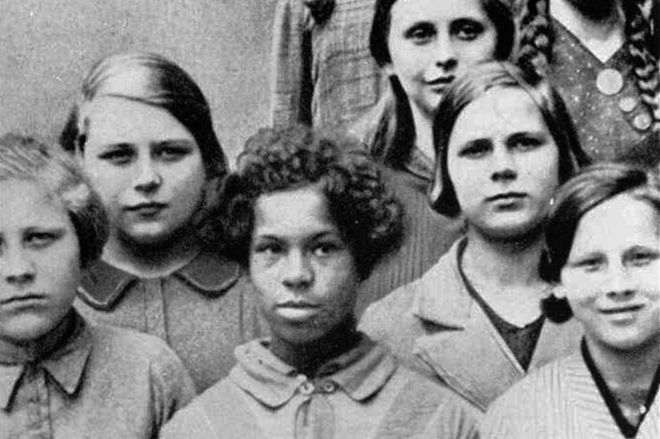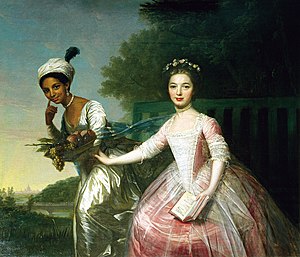Race & Ethnicity
Related: About this forumBeing black in Nazi Germany
Film director Amma Asante came across an old photograph taken in Nazi Germany of a black schoolgirl by chance.Standing among her white classmates, who stare straight into the camera, she enigmatically glances to the side.
Curiosity about the photograph - who the girl was and what she was doing in Germany - set the award-winning film-maker off on a path that led to Where Hands Touch, a new movie starring Amandla Stenberg and George MacKay.
It is an imagined account of a mixed-race teenager's clandestine relationship with a Hitler Youth member, but it is based on historical record.
Warning: Some people may find some of the content of this article upsetting
In the Nazi era, from 1933 to 1945, African-Germans numbered in their thousands.
There was no uniform experience, but over time, they were banned from having relationships with white people, excluded from education and types of employment, and some were sterilised, while others were taken to concentration camps.
'Disbelief and dismissiveness'
But their story has largely been untold - and it has taken Ms Asante 12 years to get her account of the period on to the big screen.
"Often there's a form of disbelief, of questioning, sometimes even a dismissiveness of the difficult lives these people led," she told the BBC about the reaction she received from some when she spoke about her research for the film.
The African-German community has its origins in the country's short-lived empire. Sailors, servants, students and entertainers from present-day Cameroon, Togo, Tanzania, Rwanda, Burundi and Namibia came to Germany.
Much more: https://www.bbc.com/news/world-africa-48273570

This photo was used in genetics lectures at Germany's State Academy for Race and Health Library of Congress

appalachiablue
(42,908 posts)racism and eugenics in the West keeps unfolding. Will we ever come to terms with the massive damage and misery of this legacy. I knew of the Rhineland children but not the full story, and that of German atrocities in colonial Africa namely Namibia until recently.
Amma Asante's excellent historical film 'Belle' set in 18th c. England, focuses on young Dido and the 1783 high court case of the slave ship, 'Zong Massacre' that impacted the growing abolitionist movement.

https://en.wikipedia.org/wiki/Belle_(2013_film)
Rhiannon12866
(222,224 posts)And I wasn't at all familiar with the story that I posted. I ran across it while reading something else and I thought it was worth passing on. It's not something I ever considered, what we already knew about was horrific enough. Kudos to this filmmaker for telling these overlooked stories! We need to confront all our historical nightmares so we never repeat them - current events included. ![]()
![]()
appalachiablue
(42,908 posts)in art and history, so learning about her and seeing the portrait was a real surprise. The movie is an introduction to Belle's life, about which little is known and broader themes namely the legal course of slavery and abolition in the next 50 years. The Namibian genocide of 1904-1908 by Germany is considered the first one of the 20th century, another horror of history we must never repeat as you said.

https://en.wikipedia.org/wiki/Herero_and_Namaqua_genocide
Rhiannon12866
(222,224 posts)I did particularly well in what was called "World History" back in the day - and of course the WWI and WWII/nazi period was covered in depth - but we missed so much! Thanks so much for sharing this story! I've always said that I learn something new on DU every day, and today has been exceptional! ![]()
![]()
DumpTrump20202020
(109 posts)Its sad to read about this.... It's just skin!
Rhiannon12866
(222,224 posts)And skin color wasn't something I noticed, don't remember anyone mentioning it, not my parents or grandparents or teachers. I believe prejudice is something that is learned. ![]()
Welcome to DU! ![]()
Kind of Blue
(8,709 posts)and for years, Dido Belle was identified as a servant. A few years ago, Afro-Europeans began wondering out loud and researching who were these Africans identified as servants or slaves. I really think this eventually led to the movie as well as research and rethinking black identification by some European museums. Recently, for instance, Paris museum renames masterpieces after black subjects https://www.france24.com/en/20190326-paris-musee-orsay-black-models-racism
But Dr. Henry Louis Gates is leading the field in the U.S. at Harvard.
In the 1960s, art patrons Dominique and Jean de Menil founded an image archive showing the ways that people of African descent have been represented in Western art from the ancient world to modern times. Highlights from the image archive, accompanied by essays written by major scholars, appeared in three large‐format volumes, consisting of one or more books, that quickly became collector’s items. A half‐century later, Harvard University Press and the Du Bois Institute are proud to have republished five of the original books and five completely new ones, extending the series into the twentieth century. http://www.hup.harvard.edu/catalog.php?isbn=9780674052697
It's been really fantastic these last 10 years-or-so knowing who these people were and their stories.
appalachiablue
(42,908 posts)these individuals have finally been attributed. I want to review and get back to you. Appreciate it!
![]()
Kind of Blue
(8,709 posts)Kind of Blue
(8,709 posts)on Theodor Wonja Michael, mentioned in the article, when his book came out. I'm so glad he lived long enough to summon his wherewithal to tell of his experience.
This video expands more on Michael's life and is part of a series called
schwarzrotgold tv, Schwarz Rot Gold - Black German Narratives. “Schwarz Rot Gold” (translates to black, red, gold) travels through Germany to speak to successful Black Germans about the past, present and future of German identity and racism.
Growing up in Germany, Jermain Raffington yearned for idols that he could identify with. So Jermain and his wife Laurel decided to find these idols and initiated the project “Schwarz Rot Gold”. They want their own and other children to grow up in a tolerant Germany – in an environment that inspires them to pursue their goals. https://www.facebook.com/schwarzrotgold.tv/
Sadly to me though, I can't find the identity of the little girl in the photo that's been used a lot in articles to promote Where Hands Touch. She, as with many of our ancestors used in anti-black propaganda, are lost and so are their real stories.